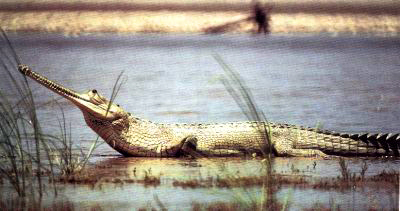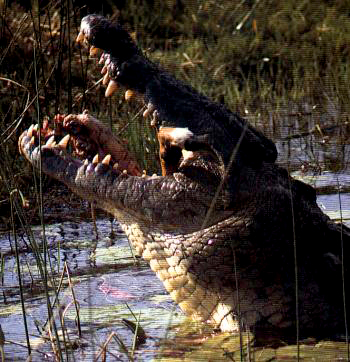 Gharials are dying from a mysterious disease.
Gharials are dying from a mysterious disease.~ Jura
Croc articles
 Gharials are dying from a mysterious disease.
Gharials are dying from a mysterious disease.~ Jura

_Crocodylus niloticus_ eating an impala. Do you see tears?
We’ve all heard the old wives tale about crocodiles crying during feeding. Many of us have probably also run across numerous references that discount this statement. That said, there has never been much scientific interest in determining whether, or not crocodiles actually cry.That has just changed:
Shaner, D.M., and Vliet, K.A. 2007. Crocodile Tears: And thei eten hem wepynge. Bioscience. Vol. 57. No. 7: 615-617. doi: 10.1641/B570711
The subtitle there translates to: “And they eat them weeping.”
The aforementioned authours were studying an apparent phenomenon in humans called: parareflexes. The hypothesis for this goes that a screwup in our normal genetic makeup, may result in the expression of traits/behaviours from an older phylogenetic time. Interestingly, the hypothesis came about from the supposed phenomenon of crocodile tears. In this case, the hypothesis is assuming that the trait of crying while eating, is one that was found in the last common ancestor between humans and crocodiles (over 300 mya). Er, yeah.
Coming back to the story, the authours tested Alligatorids (2 caiman species and the American alligator) from the St. Augustine Alligator Farm in St. Augustine Florida, USA (highly recommended for folks who like crocs). The animals were trained to walk up on the bank, out of the water, and accept food from there. All the animals were dry when they came up to eat.
The results showed that crocodylians do cry while eating. At least, they seem to when eating away from water (rather hard to tell if they are crying while in the water). They also show a large amount of bubbling around their eyes. Stranger still, the eyes cry at different rates (i.e. one eye has more bubbles and water than the other).
So what does it all mean?
That, the authours didn’t delve too much into. They mentioned that the phenomenon they witnessed was different from the one mentioned on Adam Britton’s site. The authours suggest that this might be a byproduct of crocodylian anatomy. Due to the extensive sinuses found in crocodylian skulls (see: here), there is a connection between the nasolachrymal duct (the nose/tear ducts) and the nasopharynx (where the internal nostrils meet the throat). The authours speculate that during bouts that involve pushing air back and forth through this duct (e.g. feeding, or extensive fighting), the lachrymal glands are stimulated to release tears. This would also explain why there was bubbling found in nearly all the animals studied.
So crocodylians cry; but they still don’t seem to do it out of remorse. I guess this makes the old wives tale only partially true.
~Jura

For over twenty years now it has been assumed that there is a black and white divide between bone histology and thermophysiology. Automatic endothermic “warm blooded” animals tend to show a haphazard composition of bone deposition, in which bone is laid down around surrounding blood vessels very quickly, with interspersals of more organized bone deposition (for strength). The term, coined by histologist Armand de Ricqles (1980), is fibrolamellar bone.
In contrast, bradymetabolic “cold-blooded” animals tend to show a regular deposition of layered, or lamellar zonal bone. This bone is not as well vascularized as fibrolamellar bone, and is often deposited at a much slower rate.
Back in 1980, this evidence was used along with a chain of other circumstantial evidence to show that dinosaurs were actually “warm-blooded” animals (Bakker, 1980). This challenge did not go unanswered, and even back then there were people questioning the evidence being proposed in favour of dinosaurian automatic endothermy. As far back as 1982, there were authours claiming to have histological evidence of fibrolamellar, “warm-blooded” bone growth in crocodylians (Ferguson et al, 1982). This evidence has often been scoffed at as being questionable at best (Horner & Padian, 2004). Skeptics have pointed out that the fibrolamellar crocodylians mentioned have all been captives. Being kept in a stable environment with easy access to food has resulted in these skewed results. Wild individuals would doubtfully show these traits, as access to scenarios like those provided in captivity, are unlikely.
For awhile this seemed to keep the argument of fibrolamellar bone, strictly in the pro-automatic endotherm camp. Well, not anymore.
Tumarkin-Deratzian, A.R. 2007. Fibrolamellar bone in adult Alligator mississippiensis. Journal of Herpetology. Vol. 41. No.2:341-345.
This paper reports the observation of long bone histology in alligators from Lake Griffin in Lake County, Florida. The findings are most interesting. Seven specimens were studied. Of these, three had extensive fibrolamellar growth in their long bones. In fact, one could put a fibrolamellar individual next to a lamellar zone individual and it would look like one was comparing a “classic mammal” to a “classic reptile.” The difference is incredibly dramatic; even moreso than comparing frame A with frame C in the above picture.
That’s not the best part though. You see, these lake Griffin alligators were not only wild animals, but they were stressed animals too. Currently the Lake Griffin alligator population is suffering from an intense die off. The reasons behind the high mortality at Lake Griffin remain uncertain, but there seems to be a link to thiamine deficiency in the animals dying.
This means that, not only are we seeing different bone deposition patterns in animals from the same population, but we are also seeing them from animals that were living under stressed conditions. This throws the whole “crocodylians can only show automatic endothermic growth rates under perfect conditions” argument right out the window.
So what does fibrolamellar deposition really show? Currently it remains unknown. It might still indicate faster growth. What it doesn’t indicate, though, is the thermophysiological preference of the animal in question.
Id est: it doesn’t seperate the “warm-bloods” from the “cold-bloods.”
More to come. Stay tuned.
~Jura
A little over 30 years from when it was originally put on the endangered species list, the American crocodile (Crocodylus acutus), has been officially moved from “endangered” to “threatened.”

Though the animal remains endangered in South America, in the states things seem rosier.
In Florida the animals have gone from a scant 300 wild animals, to 2,000. Though this pales in comparison to the amazing comback that the American alligator (Alligator mississippiensis) made (over 1 million individuals live in the Southern U.S.), it is still an impressive bounceback.
Kudos to the American croc and the conservationists who worked tirelessly to bring it back from the brink.
Last week the long running PBS series, Nature, showed an episode entitled: “Supersize Crocs”. The premise was to follow croc conservationist, Rom Whitaker as he attempted to see if any 20+ foot crocodiles survive today.
Unfortunately, much like the Discovery Channel’s “In Search of the Giant Squid” documentary, the results garnered from this doc were inconclusive at best. By the end of the show, the largest croc actually found, was 18ft long. Compared to the late, great Steve Irwin’s attempts at finding giant crocs, it would appear that Whitaker was short by 1 foot. There was some allusion to a 20 foot beast that was seen briefly before it ran into the water. Unfortunately Whitaker could only give a guestimate of its size based of its slide print (which was not all that clear).
Overall, the documentary made for a nice hour long diversion. There was a lot of crocodile measuring, and some unecessary CGI used to explain crocodylian anatomy. It also featured Croc biologist, Adam Britton, though only for about 10 seconds.
There were, however, some problems with the program that bugged me.
First, was the purported maximum size. Whitaker wanted to find a 20 ft croc. During the program he ran into a person who said that he had seen a 22ft individual. He said that this was 2ft longer than the longest individual ever recorded. The problem with this is that there have been reports of saltwater crocodiles (Crocodylus porosus) reaching sizes of 23 ft. While not all these reports may be valid, there are enough credible ones to suggest that they once could reach this size (Ross, and Magnusson, 1989).
My second qualm comes from Whitaker’s statement that crocodiles grow slowly. In the documentary, Whitaker states that the largest crocodiles (the 20+ footers) would have taken 80 years to reach that size. That is a completely unrealistic statement. Most crocodylians studied to date, tend to take between 10-15 years to reach sexual maturity. At this point they are often very close to their maximum size. From this point on, growth slows substantially (though never completely stops). Large crocodiles might live to 80 years old (some may be centennial), but they don’t take 80 years to get there.
My final problem with the program was that it continues to promote the myth that crocodylians have remained unchanged for over 200 million years. Crocodylians (i.e. Eusuchia) weren’t even around 200 million years ago. In fact, true crocodiles are a fairly recent group, having evolved around 80 million years ago (something that the Nature website gets correct, but the actual documentary does not). They are but one branch of a highly successful group of animals called crocodyliformes; which in turn are a branch of the highly successful crocodylomorphs. Finally, all are members of the Dinosaurian sister group: Crurotarsi, or Pseudosuchia (for those who would like to continue the croc naming trend).
The only reason why crocodiles always get lumped into the “living fossil” category, is because the bodyplan that they do have, happens to have been a popular bodyplan for the past 200 + million years. Crocodylians are just the latest group to use it. Before them, there were pholidosaurs, and way before all that, we had phytosaurs.
Calling crocs living fossils, is doing a disservice to their lineage. Just among the Crocodylia, we had such out there animals as the land dwelling, panzercroc Pristichampsus, and the weird Australian mekosuchines (e.g. Quinkana, Mekosuchus, Trilophosuchus, to name a few).
Not to mention strange behemoths such as the “duck billed” Purussaurus.
Regardless, the point is that crocs are way more diverse than they are ever given credit for.
Overall, I’d say the best part of the entire documentary would be the scenes of freshwater crocs (C.johnstoni) galloping into the water.
Oh, and the only reason I’m bringing this up now is because I just saw it last night.
~Jura
Refs:Ross, C.A. and Magnusson, W.E. 1989. “Living Crocodilians” in Crocodiles and Alligators. Ross, C.A. ed. Facts on File pg: 68